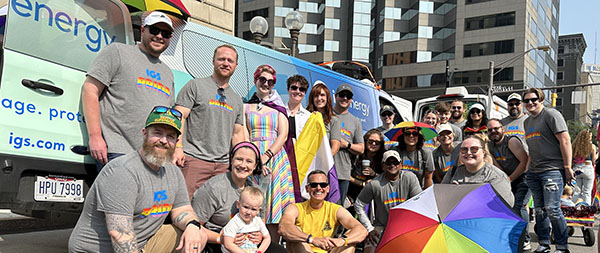How IGS Communities Enhance Our Workplace Culture

The following article recently published in HRO Today, a media company that publishes magazines, web content, newsletters, and original research for HR decision-makers. You can access the original article on HRO Today's website here.
Inclusion plays a foundational role in many workplace elements, like engagement, retention, satisfaction, and productivity. Yet, a recent survey showed that 50 percent of workers feel excluded and isolated, and when it comes to Black employees, that number jumps to more than 75 percent. To fix this, leaders can provide outlets that foster equity, wellness, and connection — cue employee resource groups (ERGs).
ERGs are associations of people and allies in the workplace with similar interests, backgrounds, struggles, and more, coming together to create a safe space for exchange.
In a recent survey, 90 percent of respondents said that ERGs offer opportunities for professional development, skills building, and growth. And Jenni Kovach, chief people officer at IGS Energy, says they’ve recently grown in importance because they galvanized employees in more ways than one.
“Employee groups have become increasingly prevalent in recent years, as employees place more and more value on having spaces in which to bond over shared experiences, expand their worldview, and make an impact where they live and work,” she says. “They offer a unique opportunity to foster a culture of inclusion and belonging, as well as opportunities to network with people across the business.”
When ERGs, or “Communities” as IGS Energy calls them, were introduced two years ago, IGS wanted to ensure employees had as much input as leaders. After all, these groups were brought in to support them and not the other way around.
“Though we’ve always had opportunities for employees to connect with like-minded people, we intentionally chose not to pre-establish employee groups, instead, encouraging our employees to offer their ideas and take part in this effort,” she says. “Communities are intended to be identified, created, and led by employees, and employees share with the organization which groups they’d like to create.”
Some of the most common ERGs found in the workforce include groups for working parents, Black employees or employees of color, individuals with disabilities, and members of the LGBTQ+ community. In fact, a survey discovered that 42 percent of LGBT+ respondents reported experiencing non-inclusive behaviors at work, but 93 percent say that ERGs have helped them feel like they belong. And research from Qualtrics shows that employees who feel like they belong at work are almost three times as likely to have a greater sense of well-being: 78 percent versus 28 percent.
Kovach was instrumental in curating her company’s “Communities” to help drive diversity, equity, inclusion, and belonging (DEIB).
“These employee groups offer a platform for traditionally underrepresented employees to have a collective voice and be able to discuss and amplify the issues that matter to their communities most.”
Four of IGS’ Communities include:
- IGS Pride (supporting LGBTQIA+ employees);
- Living La Vida Latinx (supporting Latinx employees);
- Melanin Moments (supporting Black and African American employees) and;
- IGS Women’s Network (supporting the women of IGS).
While some feel that ERGs aren’t as effective or fruitful as they claim to be, especially since they’re almost never mandatory, pressurizing participation could prove counterproductive to the end goal.
Kovach says that having them remain voluntary will guarantee that those who join are there because they genuinely want to be. “Giving employees the choice to join a ‘Community’ that they identify with and determine their level of involvement in is important to ensure our employees experience these groups in a meaningful and uniquely fulfilling way,” she says. “Our stance is that participation should be voluntary and encouraged. We see our ‘Communities’ as a valuable benefit for employees [that] they’re invited to experience in the way that best suits them and their life.”
To ensure longevity, Kovach says that leaders must provide the necessary assistance and resources to keep them thriving, as is done at IGS. “We assist employees in creating and managing these groups, we’ve developed resources that ensure they have structure, leadership, and a set of goals and outcomes they’re focused on,” she says. “Communities are required to have a leader-sponsor that lends support and guidance, and each group receives a budget to financially support their programming, events, supplies, and resources that are part of their work.”